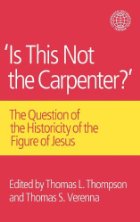 Niels Peter Lemche is the author of the fourth chapter of ‘Is This Not the Carpenter?’, “The Grand Inquisitor and Christ: Why the Church Does Not Want Jesus”. He frames his case around the parable in Dostoyevsky’s novel, The Brothers Karamazov, that tells of Christ being arrested on his return to earth in the time of the Spanish Inquisition. The Grand Inquisitor informs the imprisoned Christ that he will have to be burned at the stake because he is a danger to the Church. But there is a subtle twist in the parable which is the key to understanding the paradoxical argument that follows.
Niels Peter Lemche is the author of the fourth chapter of ‘Is This Not the Carpenter?’, “The Grand Inquisitor and Christ: Why the Church Does Not Want Jesus”. He frames his case around the parable in Dostoyevsky’s novel, The Brothers Karamazov, that tells of Christ being arrested on his return to earth in the time of the Spanish Inquisition. The Grand Inquisitor informs the imprisoned Christ that he will have to be burned at the stake because he is a danger to the Church. But there is a subtle twist in the parable which is the key to understanding the paradoxical argument that follows.
But before starting, let me point out that this post is different from earlier ones discussing chapters of this book. Rather than sequentially paraphrasing the argument I take some core arguments in Lemche’s chapter as a springboard for discussion of my own observations. (So I omit all reference to the origins of historical-critical scholarship, liberation theology and third world exegesis, Philipp Gabler‘s famous lecture on the conflict between historical theology and ecclesiastical dogmatics, the various ways both Catholics and Protestants have historically controlled the reading of the Bible, Marcion’s and von Harnack’s complaints about the inclusion of the Jewish scriptures in the Christian Bible . . . . , that Lemche covers in this chapter.) Now back to the parable. . . .

The parable is told by Ivan Karamazov who appears to side with the Inquisitor in objecting to the Jesus Christ who walks straight out of the pages of the Gospels and begins performing miracles etc just as he did there. (There is much more to the original story, but let’s roll with the details Lemche selects for his analogy.) The irony for Lemche is that this same Ivan also represents those who in other ways question the Church. The Grand Inquisitor thus turns out to be something of a double-edged sword. “Perhaps there are more layers represented in this novel than appear at first sight.”
For Lemche, the Grand Inquisitor represents “the position of the well-educated clergy of the Church“. The threats it faces come from two opposing sides, and one of these sides finds itself in an ambiguous position:
.
Threat #1 — the pious laity with their Bible
Yes, there is the threat from “the pious laity having read too much of the Bible”:
The difference between the Christ of the Church and the Jesus of the Gospels becomes dangerous when explained to the laity. (p. 77)
Elsewhere Lemche has argued that pious people should not be allowed within a hundred metres of the Bible. “Reading the Bible has not done them much good.” Some who would follow in Christ’s footsteps have been rendered harmless by being incorporated into the constraints of the Church itself (e.g. the Franciscans). Others have gone down in history as suicide cults. I and many others would add a vast array of dysfunctional mental, physical, financial and social legacies among too many of the faithful. Continue reading “Why the Church Does Not Want Jesus — ‘Is This Not the Carpenter?’ chapter 4”
